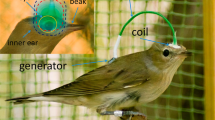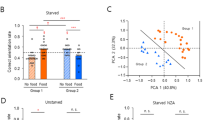Abstract
Two conflicting hypotheses compete to explain how a homing pigeon can return to its loft over great distances. One proposes the use of atmospheric odours1 and the other the Earth's magnetic field2,3,4 in the ‘map’ step of the ‘map and compass’ hypothesis of pigeon homing5. Although magnetic effects on pigeon orientation6,7 provide indirect evidence for a magnetic ‘map’, numerous conditioning experiments8 have failed to demonstrate reproducible responses to magnetic fields by pigeons. This has led to suggestions that homing pigeons and other birds have no useful sensitivity to the Earth's magnetic field9,10,11. Here we demonstrate that homing pigeons (Columba livia) can discriminate between the presence and absence of a magnetic anomaly in a conditioned choice experiment. This discrimination is impaired by attachment of a magnet to the cere, local anaesthesia of the upper beak area, and bilateral section of the ophthalmic branch of the trigeminal nerve, but not of the olfactory nerve. These results suggest that magnetoreception (probably magnetite-based) occurs in the upper beak area of the pigeon. Traditional methods of rendering pigeons anosmic might therefore cause simultaneous impairment of magnetoreception so that future orientation experiments will require independent evaluation of the pigeon's magnetic and olfactory systems.
This is a preview of subscription content, access via your institution
Access options
Subscribe to this journal
Receive 51 print issues and online access
$199.00 per year
only $3.90 per issue
Buy this article
- Purchase on Springer Link
- Instant access to full article PDF
Prices may be subject to local taxes which are calculated during checkout



Similar content being viewed by others
References
Papi, F., Fiore, L., Fiaschi, V. & Benvenuti, S. Olfaction and homing in pigeons. Monit. Zool. Ital. (N.S.) 6, 85–95 (1972)
Gould, J. L. The case for magnetic sensitivity in birds and bees (such as it is). Am. Sci. 68, 256–267 (1980)
Moore, B. R. Is the homing pigeon's map geomagnetic? Nature 285, 69–70 (1980)
Walcott, C. Magnetic orientation in homing pigeons. IEEE Trans. Magnet. 16, 1008–1013 (1980)
Kramer, G. Wird die Sonnenhöhe bei der Heimfindeorientierung verwertet? J. Ornithol. 94, 201–219 (1953)
Walcott, C. in Animal Migration, Navigation, and Homing (eds Schmidt-Koenig, K. & Keeton, W. T.) 143–153 (Springer, Heidelberg, 1978)
Keeton, W. T., Larkin, T. S. & Windsor, D. M. Normal fluctuations in the earth's magnetic field influence pigeon orientation. J. Comp. Physiol. 95, 95–103 (1974)
Wiltschko, R. & Wiltschko, W. Magnetic Orientation in Animals (Springer, Heidelberg, 1995)
Griffin, D. R. Ecology of migration: is magnetic orientation a reality? Q. Rev. Biol. 57, 293–295 (1982)
Wallraff, H. G. Simulated navigation based on assumed gradients of atmospheric trace gases (Models on pigeon homing Part 2). J. Theor. Biol. 138, 511–528 (1989)
Papi, F. Animal Homing (Chapman and Hall, London, 1992)
Carman, G. J., Walker, M. M. & Lee, A. K. Attempts to demonstrate magnetic discrimination by homing pigeons in flight. Anim. Learn. Behav. 15, 124–129 (1987)
Walker, M. M. & Bitterman, M. E. Conditioned responding to magnetic fields by honeybees. J. Comp. Physiol. A 157, 67–71 (1985)
Walker, M. M. Learned magnetic field discrimination in yellow-fin tuna, Thunnus albacares. J. Comp. Physiol. A 155, 673–679 (1984)
Walker, M. M. et al. Structure and function of the vertebrate magnetic sense. Nature 390, 371–376 (1997)
Davison, M. C. & Tustin, R. D. The relation between the generalized matching law and signal-detection theory. J. Exp. Anal. Behav. 29, 331–336 (1978)
Delius, J. D. in Physiology and Behaviour of the Pigeon (ed. Abs, M.) 327–355 (Academic, London, 1983)
Ritz, T., Dommer, D. H. & Phillips, J. B. Shedding light on vertebrate magnetoreception. Neuron 34, 503–506 (2002)
Williams, M. N. & Wild, J. M. Trigeminally innervated iron-containing structures in the beak of homing pigeons, and other birds. Brain Res. 899, 243–246 (2001)
Fleissner, G. et al. Ultrastructural analysis of a putative magnetoreceptor in the beak of homing pigeons. J. Comp. Neurol. 458, 350–360 (2003)
Walcott, C., Gould, J. L. & Kirschvink, J. L. Pigeons have magnets. Science 205, 1027–1029 (1979)
Beason, R. C. & Semm, P. Does the avian ophthalmic nerve carry magnetic navigational information? J. Exp. Biol. 199, 1241–1244 (1996)
Diebel, C. E., Proksch, R., Green, C. R., Neilson, P. & Walker, M. M. Magnetite defines a vertebrate magnetoreceptor. Nature 406, 299–302 (2000)
Beason, B. C., Wiltschko, R. & Wiltschko, W. Pigeon homing: effects of magnetic pulses on initial orientation. Auk 114, 405–415 (1997)
Walker, M. M. On a wing and a vector: a model for magnetic navigation by homing pigeons. J. Theor. Biol. 192, 341–349 (1998)
Papi, F., Luschi, P., Akesson, S., Capogrossi, S. & Hays, G. C. Open-sea migration of magnetically disturbed sea turtles. J. Exp. Biol. 203, 3435–3443 (2000)
Mouritsen, H., Huyvaert, K. P., Frost, B. J. & Anderson, D. J. Waved albatrosses can navigate with strong magnets attached to their head. J. Exp. Biol. 206, 4155–4166 (2003)
Benhamou, S., Bonadonna, F. & Jouventin, P. Successful homing of magnet-carrying white-chinned petrels released in the open sea. Anim. Behav. 65, 729–734 (2003)
Bonadonna, F. & Bretagnolle, V. Smelling home: a good solution for burrow-finding in nocturnal petrels? J. Exp. Biol. 205, 2519–2523 (2002)
Schmidt-Koenig, K. in Physiology and Behaviour of the Pigeon (ed. Abs, M.) 267–283 (Academic, London, 1983)
Acknowledgements
C.V.M. was formerly Cordula V. Haugh. This work was supported by grants from the Auckland University Research Committee. We thank J. Longville for supplying the pigeons, M. Williams for advice on the use of anaesthetics, B. McArdle for help with statistical analysis, V. Ward for graphical support and R. Mora for technical support.
Author information
Authors and Affiliations
Corresponding author
Ethics declarations
Competing interests
The authors declare that they have no competing financial interests.
Supplementary information
Supplementary Methods
This text describes the pre-training and forced-choice training methods used to prepare four homing pigeons (Columba livia) for the conditioned choice discrimination procedure. It also details the procedure itself, which was used in the baseline and impairment experiments to test individually the magnetic discrimination performance of the pigeons. (DOC 40 kb)
Supplementary Figure 1
This flowchart illustrates the structure of the conditioned choice discrimination procedure used in the baseline and impairment experiments to test individually the magnetic discrimination performance of four homing pigeons (Columba livia). (PDF 23 kb)
Rights and permissions
About this article
Cite this article
Mora, C., Davison, M., Martin Wild, J. et al. Magnetoreception and its trigeminal mediation in the homing pigeon. Nature 432, 508–511 (2004). https://doi.org/10.1038/nature03077
Received:
Accepted:
Issue Date:
DOI: https://doi.org/10.1038/nature03077
This article is cited by
-
Smart sharks: a review of chondrichthyan cognition
Animal Cognition (2023)
-
A Novel Pigeon Nesting Algorithm Based on the Nesting Behaviour of Pigeon for Health Monitoring of Structure
Journal of Vibration Engineering & Technologies (2023)
-
Corneal sensitivity is required for orientation in free-flying migratory bats
Communications Biology (2021)
-
Anosmic migrating songbirds demonstrate a compensatory response following long-distance translocation: a radio-tracking study
Journal of Ornithology (2020)
-
Advancements in pigeon-inspired optimization and its variants
Science China Information Sciences (2019)
Comments
By submitting a comment you agree to abide by our Terms and Community Guidelines. If you find something abusive or that does not comply with our terms or guidelines please flag it as inappropriate.



